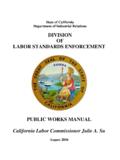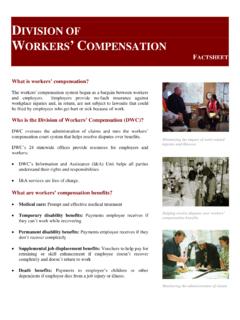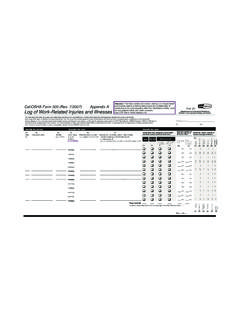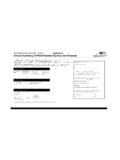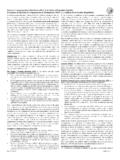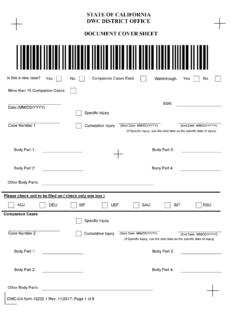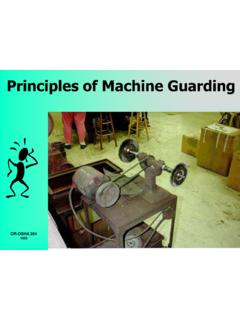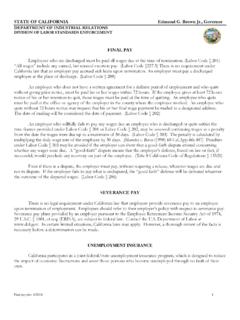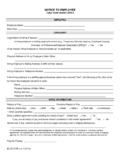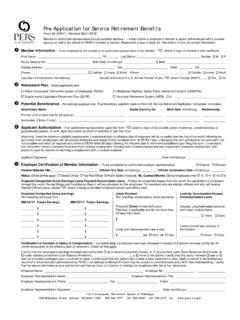Transcription of Chapter 7. Permanent Disability Benefits
1 Chapter 7. Permanent Disability Benefits What are Permanent Disability Benefits ? Most workers recover from their job injuries. But some continue to have problems. If your treating doctor says you will never recover completely or will always be limited in the work you can do, you may have a Permanent Disability . This means that you may be eligible for Permanent Disability (PD) Benefits . You don't have to lose your job to be eligible for PD Benefits . On the other hand, if you lose income because of a Permanent Disability , PD Benefits may not cover all the income lost. What is a P&S report? When you reach a point where your medical condition is not improving and not getting worse, your condition is called Permanent and stationary (P&S). This is referred to as the point in time when you have reached maximal medical improvement (MMI). When this happens, your primary treating physician writes a P&S report.
2 The P&S report should describe: Other Benefits Specific medical problems, such as how much you can move the injured parts of your body and how Besides PD. much pain you have. If you have a Permanent Limits on the work you can do. These are called work restrictions. Disability , you may also be eligible to receive: Medical care that you may need in the future for your injury. Medical care for your Whether you are able to return to your old job. injury, described later An estimate of how much your Disability is caused by your job, compared to how much it is caused by in this Chapter . other factors. (Note: You must answer questions from your treating doctor concerning other medical A supplemental job problems that may be causing your Disability .) displacement benefit. Your primary treating physician sends the P&S report to the claims administrator. To learn about this benefit, see Chapter 8.
3 Important! The P&S report will affect your future Benefits . You have a right to receive a copy of it. Request in writing that the claims administrator or your doctor give you copies of all medical reports. Other financial help, such as Social Security Your primary treating physician must use special language to describe your Disability . This language Disability Benefits and affects your Benefits . If you have questions, ask the doctor. Read the P&S report carefully, make sure it's Benefits offered by complete, and see if you agree with the doctor's conclusions. Information that is incorrect or left out could some employers and result in loss of some Benefits . unions. To find out about these Benefits , use the resources in Chapter 10. A Guidebook for Injured Workers 31. Chapter 7. Permanent Disability Benefits I don't agree with the P&S report. What can I do?
4 Sometimes different doctors have different opinions about a worker's Disability . You have a right to challenge the P&S report. To review the steps you can take if you disagree with a medical report, see Chapter 4, pp. 15-17 and 20. What is a rating? A rating is a percentage that estimates how much your Disability limits the kinds of work you can do or your ability to earn a living. It determines the amount of your PD Benefits . Ratings are based on several factors: 1. Your medical condition, as described in the P&S report or in a medical-legal report (medical-legal reports are described in Chapter 4, p. 17). 2. Your date of injury. 3. Your age when injured. 4. Your occupation (based on your job at the time of injury). 5. How much your Disability is caused by your job, compared to how much it is caused by other factors. This is called apportionment.. 6. Multiplication by an adjustment factor: If you were injured in 2013 or later, the adjustment factor is If you were injured before 2013 and your Permanent Disability is rated using the 2005 rating schedule (described in the box Rating Schedules), the adjustment factor is based on your reduced future earning capacity.
5 A rating of 100 percent means that you have a Permanent total Disability . Ratings of 100 percent are very rare. A rating between 1 percent and 99 percent means you have a Permanent partial Disability . Most injured workers do not have a Permanent Disability , and those who do usually have ratings between 5. percent and 30 percent (if injured before 2005). Rating Schedules The Schedule for Rating Permanent Disabilities is used to rate disabilities based on the factors listed above. There are three schedules: 1. 2005 rating schedule. If you were injured in 2005 or later, the 2005 rating schedule applies to you. 2. 2005 or 1997 rating schedule. If you were injured between April 1997 and December 2004 and, prior to 2005, there was no comprehensive medical-legal report or no report by a treating physician indicating that you had a Permanent Disability , or your employer was not required to send you a notice about PD Benefits , then the 2005 rating schedule applies to you.
6 Otherwise, the 1997 rating schedule applies to you. 3. 1988 rating schedule. If you were injured before April 1997, in most cases the 1988 rating schedule applies to you. To see the schedules, contact an Information & Assistance officer (see pp. 48 49). To view the schedules, go to the Division of Workers' Compensation website: 32 Workers' Compensation in California Chapter 7. Permanent Disability Benefits Examples of Permanent Disability Ratings These examples are not adjusted for age, occupation, or other factors causing the Disability (apportionment). Disability INJURY IN 2005-2012 INJURY IN 2013 OR LATER. Total loss of vision in one eye, 22% (adjusted for reduced 28% (adjusted by factor of ). normal vision (20/20) in other eye future earning capacity ) Amputation of index finger 9% (adjusted for reduced 11% (adjusted by factor of ). at middle joint future earning capacity ).
7 How is my Disability rated? The P&S report is the first major step in the rating process: If the 2005 rating schedule applies to you (see Rating Schedules box on p. 32), when your treating doctor writes the P&S report, he or she must rate your impairment, or how much you have lost the normal use of injured parts of your body. The doctor's methods for rating your impairment must follow guidelines published by the American Medical Association (AMA). If one of the earlier rating schedules applies to you, your treating doctor is not required to rate your impairment in the P&S report. Instead, the doctor must describe your Disability according to factors listed in the rating schedule that applies to you. To review the steps you can take if you disagree with a medical report, see Chapter 4, pp. 15-17 and 20. Next, you, your attorney, or the claims administrator can ask a Disability rater to rate your Disability based on the P&S report.
8 (If you were examined by a QME and don't have an attorney, a Disability rater will automatically rate your Disability .) Also, the claims administrator and your attorney may each try to predict a rating that a workers' compensation judge would consider appropriate. I disagree with the rating by the claims administrator. What can I do? You have a right to challenge the rating. Different people reviewing the same medical report will sometimes rate a worker's Disability differently. You or your attorney (if you have one) can negotiate with the claims administrator over the correct rating of your Disability . You can request a rating by a Disability rater and use this rating in your negotiations. If you and the claims administrator can't agree on the rating of your Disability , you can request that a workers' compensation judge decide on the correct rating. A Guidebook for Injured Workers 33.
9 Chapter 7. Permanent Disability Benefits I disagree with the rating by the Disability rater. What can I do? If you don't have an attorney, you can ask the administrative director of the Division of Workers'. Compensation (DWC) to determine if mistakes were made in the medical evaluation process or the rating process. This is called reconsideration of your rating. You can also present your case to a workers'. compensation judge. To get help in requesting reconsideration or presenting your case to a workers' compensation judge, contact an Information & Assistance officer (see pp. 48 49). Ask about possible delays in the reconsideration process. If you have an attorney, he or she can present your case to a workers' compensation judge. How are PD payments determined? PD benefit amounts are set by law. The claims administrator will determine how much to pay you based on several factors: 1.
10 Rating(s) of your Disability . 2. Your date of injury. 3. Your wages before you were injured. 4. Whether or not your employer offers you work meeting the requirements listed on p. 36. See How are my PD payments affected if my employer does or doesn't offer me work? . Examples of Permanent Disability Benefits These examples are based on ratings, shown on p. 33, that were not adjusted for age, occupation, or other factors causing Disability (apportionment). They apply to workers who earned more than $435 per week before the injury and whose employer has fewer than 50 employees. Disability INJURY IN 2005-12 INJURY IN 2013 INJURY IN 2014. Total loss of vision in one eye, $19, (total) $27, (total) $34, (total). normal vision (20/20) in other eye Amputation of index finger at $6, (total) $7, (total) $9, (total). middle joint 34 Workers' Compensation in California Chapter 7.
